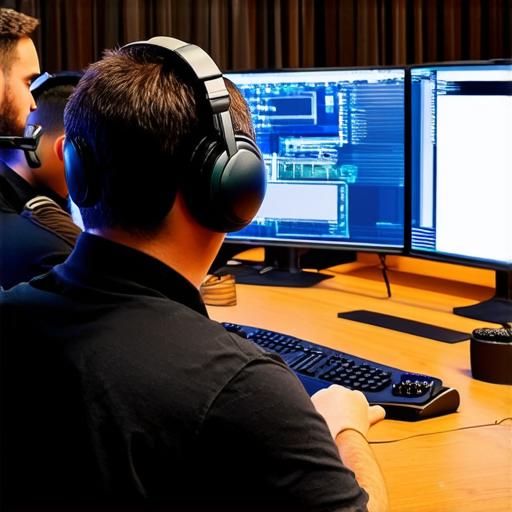Introduction
Augmented reality (AR) is a technology that overlays digital information onto the real world. It has gained significant attention in recent years, with applications ranging from entertainment to healthcare.
In this article, we will explore who develops AR software and what are the different roles involved in the development process. We will also discuss the key factors that influence AR software development, such as hardware requirements, user experience, and market trends. Additionally, we will provide a comprehensive list of AR software development tools and platforms that can be used to create AR applications.
Roles Involved in AR Software Development
1. Developers
Developers are responsible for designing and coding the AR software. They work with various technologies such as computer vision, machine learning, and graphics rendering to create interactive and immersive experiences. Developers must have a strong understanding of programming languages like Unity, Unreal Engine, and Vuforia, as well as knowledge of mobile and web development platforms.
2. Designers
Designers work with developers to create visually appealing and intuitive AR interfaces. They use graphic design tools and software to design interactive elements such as buttons, sliders, and menus. Designers must have a strong understanding of user experience (UX) principles and be able to create interfaces that are easy to navigate and understand.
3. Project Managers
Project managers oversee the entire AR software development process. They work with developers and designers to ensure that the project stays on schedule, within budget, and meets the client’s requirements. Project managers must have strong communication skills, be able to manage resources effectively, and have a good understanding of project management methodologies.
4. Quality Assurance Engineers
Quality assurance engineers are responsible for testing and verifying that the AR software meets the required quality standards. They use automated and manual testing tools to identify bugs and errors in the software. Quality assurance engineers must have a strong understanding of testing methodologies, be able to work with developers to resolve issues, and have good attention to detail.
5. Marketers
Marketers are responsible for promoting the AR software to potential users. They develop marketing strategies that target specific audiences and use social media, advertising, and other channels to generate interest in the software. Marketers must have a strong understanding of marketing principles, be able to analyze market trends, and have good communication skills.
Key Factors Influencing AR Software Development
1. Hardware Requirements
AR software development requires specialized hardware such as smartphones, tablets, and wearables. The performance and capabilities of the hardware can significantly influence the development process. Developers must choose hardware that is capable of running their software smoothly and providing a good user experience.
2. User Experience
User experience (UX) is a critical factor in AR software development. The software should be easy to use, intuitive, and engaging for the user. Developers must consider factors such as interface design, navigation, and interactivity when designing AR applications.
3. Market Trends
AR technology is constantly evolving, and market trends can significantly influence the development process. Developers must keep up with the latest developments in AR technology and incorporate them into their software. They must also be aware of changing user preferences and adapt their software accordingly.

4. Performance
Performance is a critical factor in AR software development. The software should run smoothly, without lag or delays. Developers must optimize their code and use efficient algorithms to ensure that the software runs at an acceptable speed.
5. Cost
Cost is a significant factor in AR software development. Developers must consider the cost of hardware, software, and labor when developing AR applications. They must also be aware of the potential return on investment (ROI) and ensure that the cost of development is justified by the expected revenue.
AR Software Development Tools and Platforms
1. Unity
Unity is a popular AR development platform that allows developers to create cross-platform AR applications. It provides a comprehensive set of tools and features for designing, building, and publishing AR applications. Unity supports a wide range of hardware platforms and can be used to develop both 2D and 3D AR applications.
2. Unreal Engine
Unreal Engine is another popular AR development platform that provides a powerful set of tools for creating immersive AR experiences. It is widely used in the gaming industry and can be used to develop both mobile and desktop AR applications. Unreal Engine supports a wide range of hardware platforms and provides advanced graphics rendering capabilities.
3. Vuforia
Vuforia is an open-source AR development platform that allows developers to create interactive AR experiences using smartphones and tablets. It provides a comprehensive set of tools for tracking objects, creating virtual objects, and implementing augmented reality effects. Vuforia supports a wide range of hardware platforms and can be used to develop both 2D and 3D AR applications.
4. Wikitude
Wikitude is an open-source AR development platform that provides a comprehensive set of tools for creating AR experiences. It supports a wide range of hardware platforms, including smartphones, tablets, and wearables. Wikitude provides advanced object tracking capabilities and can be used to develop both 2D and 3D AR applications.
5. Aurasma
Aurasma is an enterprise-level AR development platform that provides advanced augmented reality features for businesses. It allows developers to create customized AR experiences for their customers, including product visualization, training simulations, and marketing campaigns. Aurasma supports a wide range of hardware platforms and can be used to develop both mobile and desktop AR applications.
Conclusion
Augmented reality software development is a complex process that requires specialized skills and knowledge. Developers, designers, project managers, quality assurance engineers, and marketers all play important roles in the development process. The success of AR software development depends on factors such as hardware requirements, user experience, market trends, performance, and cost. There are several AR development tools and platforms available that can be used to create AR applications, including Unity, Unreal Engine, Vuforia, Wikitude, and Aurasma. As AR technology continues to evolve, we can expect to see even more exciting developments in the future.
